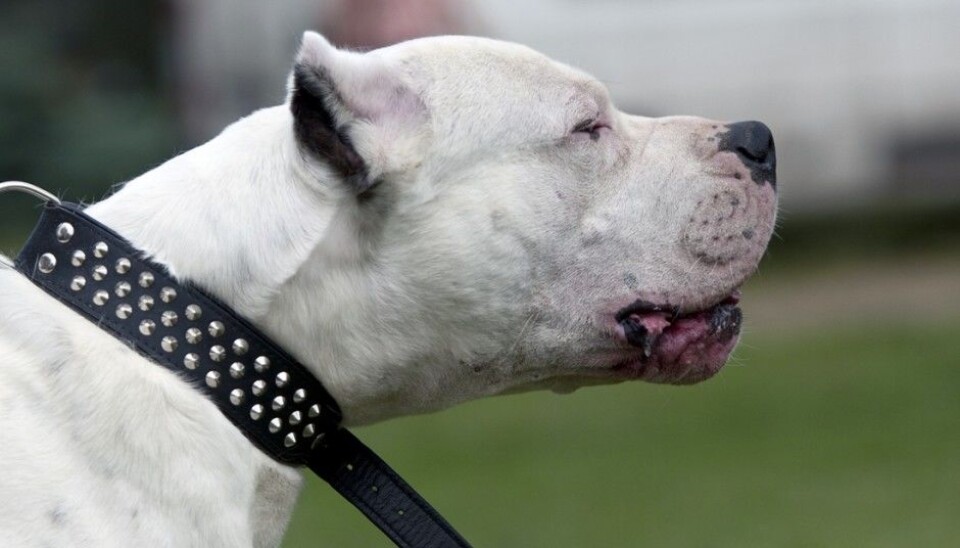An article from Norwegian SciTech News at NTNU

Training a dog you can trust
There are six breeds of dogs that are illegal in Norway. According to a dog training expert, this ban is not supported by the science.
Denne artikkelen er over ti år gammel og kan inneholde utdatert informasjon.
Ane Møller Gabrielsen received her doctorate from the Norwegian University of Science and Technology on dogs in society and culture this spring. She opposes a Norwegian ban on six dog breeds.
“I oppose racism, and this includes towards dog breeds, too,” she writes in her dissertation.
In Norway, pit bulls, American Staffordshire terriers (Amstaffs), Fila Brasileros, Tosa Inu, Dogo Argentinio and Czechoslovakian wolfhounds are all illegal.
But in the four cases where a human has been killed by a dog in the past few decades, none of the culprits were from these breeds.
The essence of the law

The difference between dog breeds is often quite small— it is actually not possible to definitively decide the breed of a dog unless it has a complete family tree, ID chip and registration.
Nonetheless, the ban on certain “dangerous” dog breeds is in many ways the essence of dog regulations in Norway. Not to say that there is no such thing as a dangerous dog, but what makes a dog dangerous has nothing to do with breed — it all comes down to treatment and training.
Gabrielsen has the support of the Norwegian Kennel Club and several other groups in her opposition to a ban on specific dog breeds.
She believes that training is the deciding factor in whether or not a dog is safe to be around, a position with which most dog owners agree.
Two main philosophies

But this is where the agreement stops with a lot of dog owners. There are two main philosophies when it comes to dog training, and they do not agree.
In addition to regulations on banned dog breeds in Norway, Gabrielsen’s dissertation looks at the conflict between the two main types of dog training used today.
There is of course many variations in these two training philosophies, but it is mainly the balance between punishment and reward that is the difference.
The debate between followers of the different training philosophies has often lead to heated discussions on net forums, where no one party is more polite than the other. Gabrielsen has studied this debate, and observed the way the two groups butt heads.
Reward
Gabrielsen has a dog herself, a boxer named Hilma.
“My dog is trained using clicker training,” she says.
Clicker training involves the training using a little device to make a clicking sound every time the dog does something right, and giving it a treat. The dog eventually learns to associate the click and the treat with that action.
Clicker training originated in the USA, and was introduced to Norway a few decades ago. Particularly younger dog owners and women tend to use reward-based training methods, and the approach is becoming more and more common. This method stems from the research of behavioural psychologists B. F. Skinner and Ivan Pavlov.
It is among the dog training methods that use reward centrally. The training is easy, both for the dog and the owner.
Punishment
On the other side are those who believe yanking on a dog’s collar when it does something wrong is much more effective. Gabrielsen disagrees.
“I’ve come to see both arguments, but i’m still completely on the side of reward. I see no reason for physical punishment,” she says.
Some people find this provoking, calling it misguided kindness, and a development in society that they don’t want any part of. The believe that only rewards won’t make your dog safe— you won’t see any results from too much kindness.
“Some people draw parallels to raising children. It is important as a parent to show who is the boss,” says Gabrielsen.
The idea behind this is also rooted in biology. A wolf pack has an unambiguous leader, and according to followers of this style of training, you have to be that alpha male.
This is the more traditional training style, rooted in Germany and in military discipline. It is often used by older dog owners, and more commonly by men.
The dog’s role is changing
Maybe the emergence of reward-based training has something to do with how dogs are used in Norway. The amount of watchdogs and hunting dogs is going down. Most people who own dogs these days want a loving, happy family member.
Research on dogs and the position of dogs in society has not been very common in Norway, and hasn’t always been very academic, despite the fact that it has become an increasingly popular topic.
“There are no exact numbers, but the number of dogs in Norway is estimated to have increased from 400 000 to 500 000 over the past decade,” she explains.
At the same time, this means that more people need to train their dogs, and find a method that works for them. The main goal of both of these philosophies is the same— to train a dog that you can trust.
But this has nothing to do with breed, Gabrielsen says.
-------------------------------------
Read the Norwegian version of this article at forskning.no


































